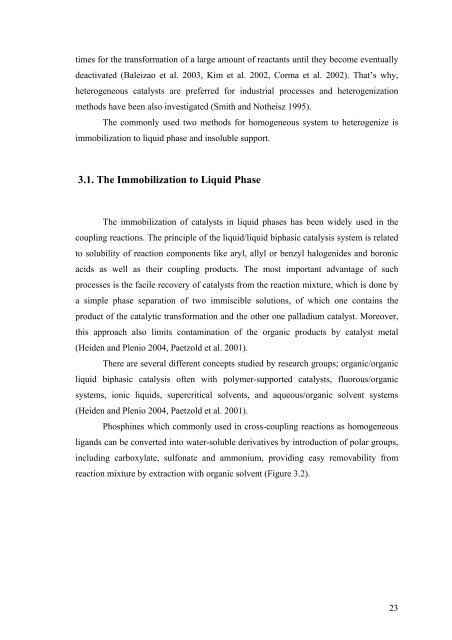chapter 2 palladium catalysts in suzuki cross- coupling reaction
chapter 2 palladium catalysts in suzuki cross- coupling reaction
chapter 2 palladium catalysts in suzuki cross- coupling reaction
You also want an ePaper? Increase the reach of your titles
YUMPU automatically turns print PDFs into web optimized ePapers that Google loves.
times for the transformation of a large amount of reactants until they become eventually<br />
deactivated (Baleizao et al. 2003, Kim et al. 2002, Corma et al. 2002). That’s why,<br />
heterogeneous <strong>catalysts</strong> are preferred for <strong>in</strong>dustrial processes and heterogenization<br />
methods have been also <strong>in</strong>vestigated (Smith and Notheisz 1995).<br />
The commonly used two methods for homogeneous system to heterogenize is<br />
immobilization to liquid phase and <strong>in</strong>soluble support.<br />
3.1. The Immobilization to Liquid Phase<br />
The immobilization of <strong>catalysts</strong> <strong>in</strong> liquid phases has been widely used <strong>in</strong> the<br />
coupl<strong>in</strong>g <strong>reaction</strong>s. The pr<strong>in</strong>ciple of the liquid/liquid biphasic catalysis system is related<br />
to solubility of <strong>reaction</strong> components like aryl, allyl or benzyl halogenides and boronic<br />
acids as well as their coupl<strong>in</strong>g products. The most important advantage of such<br />
processes is the facile recovery of <strong>catalysts</strong> from the <strong>reaction</strong> mixture, which is done by<br />
a simple phase separation of two immiscible solutions, of which one conta<strong>in</strong>s the<br />
product of the catalytic transformation and the other one <strong>palladium</strong> catalyst. Moreover,<br />
this approach also limits contam<strong>in</strong>ation of the organic products by catalyst metal<br />
(Heiden and Plenio 2004, Paetzold et al. 2001).<br />
There are several different concepts studied by research groups; organic/organic<br />
liquid biphasic catalysis often with polymer-supported <strong>catalysts</strong>, fluorous/organic<br />
systems, ionic liquids, supercritical solvents, and aqueous/organic solvent systems<br />
(Heiden and Plenio 2004, Paetzold et al. 2001).<br />
Phosph<strong>in</strong>es which commonly used <strong>in</strong> <strong>cross</strong>-coupl<strong>in</strong>g <strong>reaction</strong>s as homogeneous<br />
ligands can be converted <strong>in</strong>to water-soluble derivatives by <strong>in</strong>troduction of polar groups,<br />
<strong>in</strong>clud<strong>in</strong>g carboxylate, sulfonate and ammonium, provid<strong>in</strong>g easy removability from<br />
<strong>reaction</strong> mixture by extraction with organic solvent (Figure 3.2).<br />
23

















